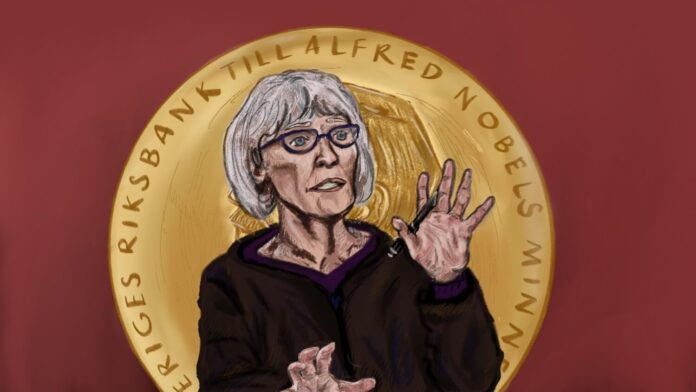Claudia Goldin, the Henry Lee Professor of Economics at Harvard University, was the recipient of the 2023 Nobel Memorial Prize in Economic Sciences for her contributions to understanding women’s outcomes in the labor market. Goldin is the first solo woman to win the Nobel — Elinor Ostrom and Esther Duflo, the two previous women to have won the prize, did so with a male co-awardee. Goldin’s work provides a mixed and fascinating picture of the state of women’s economic standing, from the turn of the 20th century up through the present day.
Claudia Goldin entered Cornell University with the goal of becoming a microbiologist, but upon taking a class with economist Alfred Kahn, switched into economics. Goldin went to graduate school at the University of Chicago, where she did her doctoral thesis in economic history under Robert Fogel, who won the Economics Nobel in 1993. After her doctorate, Goldin worked at a number of different universities until 1990 when she became the first woman to gain tenure in the economics department at Harvard University.
Goldin obtained her doctorate in 1972, in the midst of the Sexual Revolution, wherein women gained even greater freedoms to determine their relationship to their lives and families — especially with the legalization of oral contraception. At the same time, women began entering traditionally male occupations in greater numbers — from 1970 to 1980, the proportion of first year law students who were women increased from 10 percent to 36 percent, and from approximately 9 percent to nearly 30 percent in medical school.
Clearly, there is a correlation between contraception usage and this increase of women entering the professions — but did legalization of contraception directly cause it? With Lawrence Katz, Goldin found a definitive answer: yes. In their seminal paper “The Power of the Pill,” Goldin and Katz used the fact that oral contraception was legalized in different states in different years to tease out causality.
Consider two bordering states, Oregon and Washington, with similar demographics in age, income, urbanization and other factors. If Washington legalized oral contraception a few years earlier than Oregon and saw its share of women entering the professions rise while Oregon’s share remained flat, we could assume with reasonable certainty that the legalization of oral contraception played the pivotal role.
By exploiting geographic discontinuities in the expansion of access to contraception, Goldin and Katz found that expanded access to oral contraception contributed to around 30 percent of the increase in women working in professional occupations. The mechanism by which women gained access into these fields was via their ability to delay marriage — Goldin and Katz found that access to oral contraception contributed to around 30 percent of the decline in marriage before age 23 in the 1960s and 70s.
However, perhaps even more famous than her paper on oral contraception is Goldin’s voluminous body of work on women’s labor market outcomes, such as hours worked and wages. The gender wage gap, and arguments over it, have been in the news a lot — you may have heard that women earn 83 cents for every dollar a man makes, or from conservatives that personal choices in occupation and hours worked are the reason for the pay gap, and once controlled for, there is no pay gap. These are both correct — but Goldin’s research has been focused on understanding the concrete reasons beyond simple controls.
In a 2010 paper with Katz and Marianne Bertrand, Goldin tracked the hours and earnings of both men and women who graduated from Harvard Business School. The trio found that, at the beginning of their careers, men and women earned similar amounts and worked similar hours — but 10 years in, women earned and worked substantially less.
Goldin, Katz and Bertrand attribute this primarily to childbirth — women pull back from working when their first child is born, substantially depressing their hours and wages, and creating a large gap where there was once a small one.
The story of the gender wage gap goes deeper than childbirth, though. In her paper “The Grand Gender Convergence: Its Last Chapter,” published in 2014, Goldin found that certain careers have substantially lower earnings gaps than others. For example, scientists and pharmacists tend to have minimal earnings gaps, while lawyers and businesspeople tend to have large earnings gaps.
The primary reason is that law and business have “convex” pay structures — particular hours, such as working overtime during a merger and acquisition, are rewarded substantially, and missing out on these hours undoubtedly means significant wage loss in the future. Meanwhile, science and pharmacy have “linear” pay structures — working on a research paper at 9 p.m. is just as effective as working at 11 a.m. In professions with linear pay structures, shifting work hours does not lead to substantial lost wages.
Goldin’s research reveals a fundamental, complex truth — women’s labor market outcomes have improved, but much progress is still necessary. Wages for women converged from around 60 cents in 1960 up to today’s 80 cents — and that is tangible, real progress — but regaining those last 20 cents will require society as a whole to treat hours when women work as equal to hours when men work. Until then, the gender wage gap will remain stubborn as ever.
Contact Avinash Iyer at iyera@oxy.edu
![]()



































